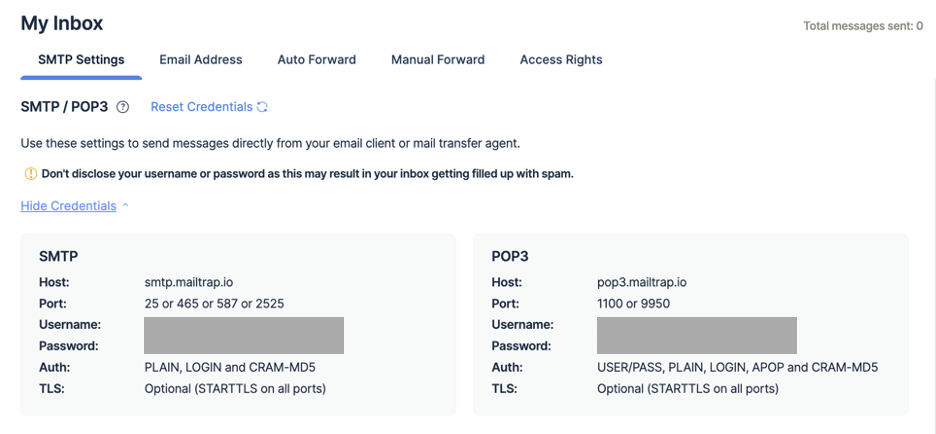In the professional world, sending emails might just be the most commonly performed task. Whether it’s to contact a colleague, share information with a user, or achieve something completely different, emails serve as an essential element of communication.
Through the Simple Mail Transfer Protocol (SMTP), emails can be sent out using a range of tools, technologies, and methods.
One popular method involves batch files – script files in DOS, OS/2, and Microsoft Windows that have the .BAT or .CMD file extension.
In this article, we will go into detail on how to send emails using batch files, starting from file creation and going all the way to email delivery and testing.
So without further ado, let’s get right into it!
How to send emails using a batch file?
Step #1 – Create the file
Creating a batch file is quite an easy task as the only two things you need are a text editor and, well, knowledge of writing scripts consisting of commands. But no worries if you aren’t a pro at the latter; we’re going to help out :).
Now, to run those files, you need a command line.
A basic command line should already be part of your operating system, but if you want something more advanced, do install it before proceeding with the next steps.
Step #2 – Select an SMTP server
As mentioned in the introduction of this article, batch files send emails through the SMTP protocol. This means that you will have to include SMTP server credentials in your batch file script.
At your disposal is a range of SMTP servers, each with its own pros and cons, which you can explore on your own. But if you are looking for a recommendation from our side, then we have to mention Mailtrap Email API/SMTP Service.
Mailtrap SMTP
Mailtrap Email API/SMTP Service provides developers with a stable email infrastructure and effortless control over the same through dashboards with crucial email stats, weekly health checks, email logs, and critical deliverability alerts in case of any unexpected issues.
What’s more, Mailtrap Email API/SMTP Service will ensure high deliverability rates, and you can reach customer inboxes in seconds.
To retrieve the credentials for the SMTP server of this sending solution, you’ll need to get yourself a Mailtrap account.
Then just log in, add and verify your domain as described on the Sending Domain Setup page of the Mailtrap knowledgebase, and navigate to SMTP/API Settings under the Sending Domains page.

Once you spot the SMTP credentials, save them in a convenient spot, as you’ll need them soon.
Popular email clients and their SMTP servers
If, for whatever reason, you decide not to go with Mailtrap and instead want to use an SMTP server offered by an email client you are familiar with; you are absolutely free to. But do keep in mind that for each one, you will have to go through a somewhat unique account setup and credentials retrieval process.
To help you out with this, at least in terms of general settings, we created this table covering three popular mailbox providers and their SMTP servers.
| Mailbox providers | SMTP server | Port | Connection |
| Gmail | smtp.gmail.com | 587, 25, 465 | TLS, SSL |
| Office 365 | smtp.office365.com | 587, 25 | TLS |
| Outlook | smtp-mail.outlook.com | 587, 25 | TLS |
Step #3 – Select an email-sending tool and write the script
Although the command line is of crucial importance in the process we are describing, on its own, it’s not capable of delivering emails. For that, you’ll need a tool/program such as SendEmail.exe, BLAT, or PowerShell.
Sending with SendEmail.exe
SendEmail.exe is a tool that can be used in batch files to send emails from the command line. It was created to ease the running of Unix code with usr/lib/sendmail hardcoded as a means of email delivery.
To start using SendEmail.exe, download its file and extract it into a folder.
Then, open your command line and paste the following script with modifications made for parameters such as the sender, recipient, server, and so on:
<SendEmail.exe path> -f <sender> -t <recipient> -s <SMTP server>:[port] -xu <Authentication Username> -xp <Authentication Password> -o tls=no -u <Subject> -m <Message>
Script version with mock data:
C:\Users\user\Documents\sendEmail\sendEmail -f sender@example.com -t recipient@example.com -s live.smtp.mailtrap.io:587 -xu **Authentication Username** -xp ****Authentication Password**** -o tls=no -u "Test email subject" -m "Test email content"
Once you run the script, your email should be delivered shortly!
Sending with BLAT
BLAT is a Windows command line utility for sending emails using SMTP. It is also capable of posting to Usenet through NNTP.
BLAT’s installation process is basically the same as SendEmail.exe’s, consisting of a .zip file download and extraction into a folder.
After installing the utility, you can use this script to send your email from the command line:
<blat.exe path> -body <Message> -u <Authentication Username> -pw <Authentication Password> -to <recipient> -f <sender> -charset utf-8 -s <Subject> -server <SMTP server> -port <Port>
Script version with mock data:
blat -body "Test email content" -u **Authentication Username** -pw ****Authentication Password**** -to "recipient@example.com" -f sender@example.com -charset utf-8 -s "Test email subject" -server live.smtp.mailtrap.io -port 587
Note: BLAT struggles to work with specific SMTP servers such as Gmail. But, if your choice falls on Mailtrap’s SMTP, you won’t have any issues.
Sending with PowerShell
PowerShell, made up of a command-line shell, a scripting language, and a configuration management framework, is a solution for configuring systems and automating tasks.
As the solution can be used on Windows, Linux, and macOS, its installation process will depend on the OS you are using, according to Microsoft’s documentation.
To send an email with PowerShell and a batch file, you will have to complete a few steps.
First, in your command line, run @ECHO OFF. This will prevent batch file commands from displaying on the screen.
Then, call PowerShell and bypass the execution policy.
CALL :PowerShell
CD /D C:\Windows\System32\WindowsPowerShell\v1.0
Powershell -ExecutionPolicy Bypass -Command "& '%CreateScript%'"
EXIT To create your script and also check if a script by the same name already exists so it can be replaced, use the following commands:
:PowerShell
SET CreateScript=%temp%\~tmpeScriptName.ps1
IF EXIST "%CreateScript%" DEL /Q /F "%CreateScript%"Script version with mock data:
:PowerShell
SET CreateScript=%temp%\~tmpTestScript.ps1
IF EXIST "%CreateScript%" DEL /Q /F "%CreateScript%"With your script created, you now need to send the output of your variables to it. This can be done by echoing said variable outputs as follows;
ECHO >> "%CreateScript%"
ECHO $Username = "<username>" >> "%CreateScript%"
ECHO $Password = "<password>" >> "%CreateScript%"
ECHO $To = "test@test.com" >> "%CreateScript%"
ECHO $From = "from@from.com" >> "%CreateScript%"
ECHO $Subject = "<Email Subject>" >> "%CreateScript%"
ECHO $Body = "<Email Body>" >> "%CreateScript%"
ECHO $SMTPServer = "smtp.client.com" >> "%CreateScript%"Script version with mock data:
ECHO >> "%CreateScript%"
ECHO $Username = "**Authentication Username**" >> "%CreateScript%"
ECHO $Password = "****Authentication Password****" >> "%CreateScript%"
ECHO $EmailTo = "recipient@example.com" >> "%CreateScript%"
ECHO $EmailFrom = "sender@example.com" >> "%CreateScript%"
ECHO $Subject = "Test email subject" >> "%CreateScript%"
ECHO $Body = "Test email content" >> "%CreateScript%"
ECHO $SMTPServer = "send.smtp.mailtrap.io" >> "%CreateScript%"The next step entails creating an SMTP client variable by calling the Net.Mail.SmtpClient function and passing it the SMTP server name and port as parameters.
ECHO $SMTPClient = New-Object Net.Mail.SmtpClient($SmtpServer, 587) >> "%CreateScript%"For your newly-created SMTP client variable, you have to enable SSL and pass it the SMTP server credentials.
ECHO $SMTPClient.EnableSsl = $true >>"%CreateScript%"
ECHO $SMTPClient.Credentials = New-Object System.Net.NetworkCredential($Username, $Password) >>"%CreateScript%" Finally, by calling the Send method and passing it the sender and recipient email addresses, the subject, and the body, send off your email.
ECHO $SMTPClient.Credentials = New-Object System.Net.NetworkCredential($EmailFrom, $Password) >>"%CreateScript%"
ECHO $SMTPClient.Send($EmailFrom, $EmailTo, $Subject, $Body) >> "%CreateScript%"
GOTO :EOFHow to send an email with an attachment using a batch file?
Even though sending emails with batch files seems quite basic, it does allow you to take things up a notch by adding attachments to the mix.
To demonstrate this, we will stick with using PowerShell for writing the script.
So, for the attachment you want to add, a variable needs to be created, and a file path has to be passed into its constructor.
ECHO $Mail = New-Object System.Net.Mail.MailMessage($EmailFrom, $EmailTo, $Subject, $Body) >> "%CreateScript%"
ECHO $Attachment = New-Object System.Net.Mail.Attachment("<File-Path>") >> "%CreateScript%"Script version with mock data:
ECHO $Attachment = New-Object System.Net.Mail.Attachment("C:\Users\user\Pictures\Screenshots\iphone.png") >> "%CreateScript%"After doing that, you simply add the attachment variable to the email variable and call the Send method.
ECHO $Mail.Attachments.Add($Attachment) >> "%CreateScript%"
ECHO $SMTPClient.Send($Mail) >> "%CreateScript%"How to test emails sent with a batch file?
Whether you are using batch files or a very complex framework to send emails, testing should be done beforehand with the proper tools. Through testing, you get to preview your emails in different email clients, check if you are triggering spam filters, spot and fix errors in your HTML/CSS code, and much more.
And while you can do email testing manually in your personal inbox without any tools, in that case, you will be cluttering your inbox with junk mail, messing up your domain reputation, and lacking access to any advanced testing features. That is why we recommend going with something like Mailtrap Email Testing, an inseparable part of Mailtrap Email Delivery Platform.
When using Mailtrap Email Testing, you have no risk of spamming real recipients with testing emails, as this tool allows you to create virtual inboxes. It also has features for validating HTML/CSS, previewing content and analyzing it for spam, reporting on domain/IP blacklist presence, forwarding to whitelisted recipients, and gaining insight into detailed tech info.
Most importantly, testing your emails with Mailtrap is easy, all you have to do is:
- Log into your Mailtrap account.
- Navigate to Sandbox – > Inboxes – > SMTP Settings.
- On the SMTP Settings page, click on Show Credentials to reveal the credentials.

- Take these credentials and include them in the part of your email-sending script shown below:
ECHO >> "%CreateScript%"
ECHO $Username = "**Authentication Username**" >> "%CreateScript%"
ECHO $Password = "****Authentication Password****" >> "%CreateScript%"
ECHO $EmailTo = "recipient@example.com" >> "%CreateScript%"
ECHO $EmailFrom = "sender@example.com" >> "%CreateScript%"
ECHO $Subject = "Test email subject" >> "%CreateScript%"
ECHO $Body = "Test email content" >> "%CreateScript%"
ECHO $SMTPServer = "smtp.mailtrap.io" >> "%CreateScript%"
ECHO $SMTPClient = New-Object Net.Mail.SmtpClient($SmtpServer, 2525) >> "%CreateScript%"
ECHO $SMTPClient.EnableSsl = $true >>"%CreateScript%"
ECHO $SMTPClient.Credentials = New-Object System.Net.NetworkCredential($EmailFrom, $Password) >>"%CreateScript%"
ECHO $SMTPClient.Credentials = New-Object System.Net.NetworkCredential($EmailFrom, $Password) >>"%CreateScript%" - Run the full Powershell script, and your test email should land in your Email Sandbox virtual inbox in seconds!
Wrapping up
For people new to this, sending emails using a batch file might sound like a joke as most expect the command line to only be used for making changes on our devices, not communicating with the “outside world”. But, thanks to tools such as Sendmail.exe, BLAT, and PowerShell, doing this proves to be very much possible.
That said, we hope you enjoyed reading this article and that it will aid you on your batch file email-sending journey!
For more email-related content, make sure to check out our blog where we cover topics like sending and testing emails/email notifications, deliverability, security, and more.



